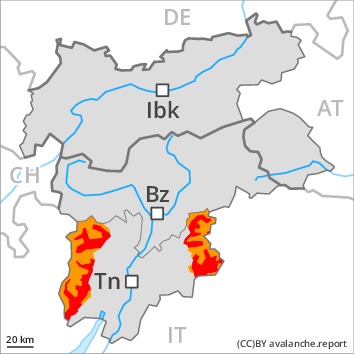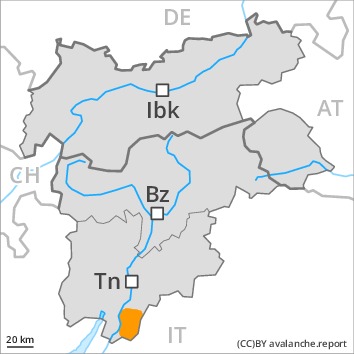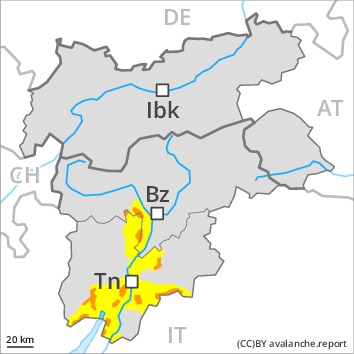
Danger level
 | 2200m
|
Avalanche Problem
 | | Gliding snow |
|  | |  |
 | | Wind-drifted snow |
|  | |  |

On steep grassy slopes natural avalanches must be expected. Fresh wind slabs are to be evaluated with care and prudence.
On steep grassy slopes gliding avalanches are possible at any time, even very large ones in isolated cases. This applies in all aspects below approximately 2200 m. Exposed parts of transportation routes can be endangered.
In addition a latent danger of dry loose snow avalanches exists, in particular in the regions exposed to heavier precipitation. Caution is to be exercised in particular in steep high-altitude starting zones that have retained the snow thus far.
The new snow and wind slabs of the last few days can be released easily, even by a single winter sport participant, in all aspects above the tree line. The number and size of avalanche prone locations will increase with altitude.
The current avalanche situation calls for extensive experience in the assessment of avalanche danger and careful route selection.
Snowpack
dp.2: gliding snow
dp.6: cold, loose snow and wind
10 to 30 cm of snow, and even more in some localities, has fallen. The strong wind has transported the new snow significantly. In some cases the various wind slabs have bonded poorly together. This applies at high altitudes and in high Alpine regions. The fresh wind slabs are covered with new snow in some cases and therefore difficult to recognise.
Tendency
The weather conditions will bring about a gradual change towards better conditions. Caution is to be exercised in areas with glide cracks.

Danger level
 | 2200m
|
Avalanche Problem
 | | Gliding snow |
|  | |  |
 | | Wind-drifted snow |
|  | |  |

On steep grassy slopes natural avalanches must be expected. Fresh wind slabs are to be evaluated critically.
On steep grassy slopes gliding avalanches are possible at any time, even very large ones in isolated cases. This applies in all aspects below approximately 2200 m.
The new snow and wind slabs of the last few days can be released easily, even by a single winter sport participant, in all aspects above the tree line. The number and size of avalanche prone locations will increase with altitude.
In very isolated cases avalanches can be triggered in deep layers of the snowpack and reach very large size. This applies in case of releases originating from very steep starting zones at high altitudes and in high Alpine regions that have retained the snow thus far.
Backcountry touring calls for extensive experience in the assessment of avalanche danger and careful route selection.
Snowpack
dp.2: gliding snow
dp.6: cold, loose snow and wind
10 to 30 cm of snow, and even more in some localities, has fallen. The strong wind has transported the new snow significantly. In some cases the various wind slabs have bonded poorly together. This applies at high altitudes and in high Alpine regions. The fresh wind slabs are covered with new snow in some cases and therefore difficult to recognise.
Tendency
The weather conditions will bring about a gradual change towards better conditions. Caution is to be exercised in areas with glide cracks.

Danger level
 | 2200m
|
Avalanche Problem
 | | Gliding snow |
|  | |  |
 | | Wind-drifted snow |
|  | |  |

On steep grassy slopes natural avalanches must be expected. Fresh wind slabs are to be evaluated critically.
On steep grassy slopes gliding avalanches are possible at any time, even very large ones in isolated cases. This applies in particular on steep sunny slopes below approximately 2200 m. Exposed parts of transportation routes can be endangered. Areas with glide cracks are to be avoided.
The new snow and wind slabs of the last few days can be released easily, even by a single winter sport participant, in all aspects above the tree line. The number and size of avalanche prone locations will increase with altitude.
In very isolated cases avalanches can be triggered in deep layers of the snowpack and reach very large size. This applies in case of releases originating from very steep starting zones at high altitudes and in high Alpine regions that have retained the snow thus far, especially at transitions from a shallow to a deep snowpack, this applies in particular in case of a large load.
The current avalanche situation calls for extensive experience in the assessment of avalanche danger and a certain restraint.
Snowpack
dp.2: gliding snow
dp.6: cold, loose snow and wind
10 to 30 cm of snow, and even more in some localities, fell in the last two days. The strong wind has transported the new snow significantly. In some cases the various wind slabs have bonded poorly together. This applies at high altitudes and in high Alpine regions. The fresh wind slabs are covered with new snow in some cases and therefore difficult to recognise. Faceted weak layers exist deep in the old snowpack in particular at high altitudes and in high Alpine regions.
Tendency
The weather effects will bring about a gradual change towards better conditions. Caution is to be exercised in areas with glide cracks.

Danger level
 | treeline
|
Avalanche Problem
 | | Wind-drifted snow |
|  | |  |
 | | Gliding snow |
|  | |  |

Wind slabs are to be evaluated with care and prudence.
The fresh wind slabs are to be evaluated with care and prudence in all aspects above the tree line. The number and size of avalanche prone locations will increase with altitude. On steep grassy slopes gliding avalanches are possible, even medium-sized ones. This applies in all aspects below approximately 2200 m.
Ski touring calls for experience in the assessment of avalanche danger and careful route selection.
Snowpack
dp.2: gliding snow
dp.6: cold, loose snow and wind
10 to 30 cm of snow, and even more in some localities, has fallen. The strong wind has transported the new snow significantly. In some cases the various wind slabs have bonded poorly together. This applies at high altitudes and in high Alpine regions. The fresh wind slabs are covered with new snow in some cases and therefore difficult to recognise.
Tendency
The avalanche danger will persist.















